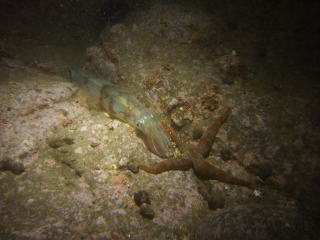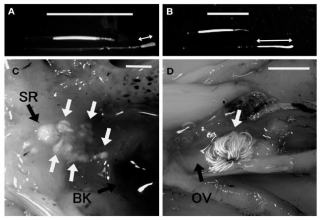Yoko Iwata's website
Research
・Sexual selection
・Evolution of life history
・Evolution of polymorphism
・Alternative mating tactics
・Sperm competition & Cryptic female choice
・Reproductive ecology in cephalopod
Loliginid squids provide an excellent opportunity to understand maintenance
mechanisms of intra-specific phenotypic diversity!!
| 1 Alternative mating tactics in squid |
Loliginid squids have a characteristic mating system, where males adopting
one of two mating tactics to pass spermatophores on "alternative sperm
storage sites" of females. Males show body-size dimorphism, associated
with alternative mating tactics.
First, I investigated the effect of body size on male competition and mating
behaviours by behavioural observations in captive. The body size of males
correlated with the outcome of male competition and mating behaviours:
large males paired with females, and small males mated with females that
have already paired with another male.
Second, I investigated the fertilization success of each mating behaviour
by paternity analysis using microsatellite DNA polymorphism. Such diverged
mating behaviors resulted in different paternity rates among males: paired
males fertilized about 90% eggs, and sneaked males fertilized the rests
(Iwata et al. 2005).
 |
Now, I am applying the study in wild. Dr Paul Shaw (Royal Holloway University
of London, UK), Dr Warwick Sauer (Rhodes University, South Africa) and
myself started SCUBA-based field study in Matsumae, Hokkaido, Japan from
2007. |
| 2 Male dimorphism associated with alternative mating tactics |
Male dimorphism has been thought to correlate with alternative mating behaviours.
Alternative mating behaviours promote asymmetry in sperm competition, and
the differences in fertilization success could promote adaptations in ejaculate
characteristics in relation to each reproductive behaviour. Using allometric
analysis, I demonstrated that there was clear ejaculate dimorphism in males
of the squid Loligo bleekeri, a species with body-size related alternative mating behaviours.
| A morphological switch point was detected in internal characters: larger individuals made discontinuously longer spermatophores than smaller individuals, although any switch point was not detected in external characters (fin length, fin width, head width, mantle width, tentacle length and hectocotylus length) except bimodal body size. |
 |
The dimorphism could be an adaptation to the characteristic alternative mating behaviours of loliginid squid, in which males pass spermatophores to alternative sperm storage sites in and on females (Iwata & Sakurai 2007).
The squid system, with clear sperm competition and constraint on it by
female characteristics, should provide some general resolution about how
male traits evolve under the selection force of post-copulatory male competition,
cryptic female choice and sexual conflict.
|

